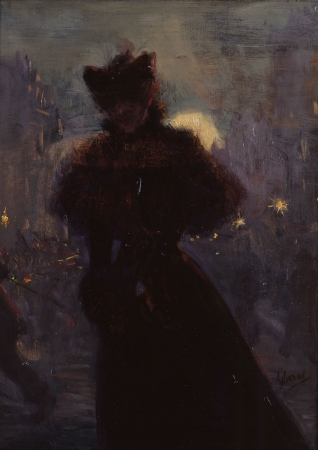CHÉRET, Woman in Black with Muff

Jules CHÉRET (1836-1932)
Woman in Black with Muff
ca. 1885
oil on canvas
33 x 25 cm
© MuMa Le Havre / Florian Kleinefenn
Woman in Black with Muff
ca. 1885
oil on canvas
33 x 25 cm
© MuMa Le Havre / Florian Kleinefenn
HD image
Jules Chéret, who Gustave Geffroy asserted had "raised the poster to the rank of mural art", painted as a leisure pursuit until 1900, when he began devoting more time to the practice. With a cheerful and pleasant character that shone through in his work, he succeeded in creating a certain ideal of the Belle Époque Parisian woman. Similar to the Impressionists, he excelled in capturing the glittering magic of the Parisian nightlife.
Woman in Black with Muff provides the perfect example of this art form, done with elegance and suggestion. The dynamic movement of the silhouetted young woman is accentuated by the furtive, half-hidden shadow of a passer-by in the left of the painting. He used this framing, which resembles the work of his friends Toulouse-Lautrec and Degas, teamed with the bright gleam of the city lights, to convey the fast-paced and ever-changing life of the Grands Boulevards. The impish nose and witty mouth of a mischievous face can be glimpsed beneath the elegant lady's half-veil.
Yet the rather dark treatment of the painting may seem surprising for an artist who usually favours airier compositions with livelier brushstrokes. The process adopted for this painting readily evokes the sketches of his contemporary Jean Béraud, who explored the same subject matters as Chéret. This atypical work demonstrates the care Olivier Senn took to broaden his collections to these epigones of Impressionism who, by the vitality and inventiveness of their art, cast their influence on the Post-Impressionist generation.
Painter and lithographer of the frivolity and futility of Parisian pleasures, Jules Chéret distinguished himself by a skilful use of primary colours that held particular interest for Seurat and Cross, and by his concise quality of drawing whose influence reached as far as the Cloisonnist investigations of Gauguin and Bernard. The Woman in Black with Muff thus establishes a link between the purely Impressionist works of his collection and the paintings of Cross, Sérusier, Bonnard and Vallotton.
Woman in Black with Muff provides the perfect example of this art form, done with elegance and suggestion. The dynamic movement of the silhouetted young woman is accentuated by the furtive, half-hidden shadow of a passer-by in the left of the painting. He used this framing, which resembles the work of his friends Toulouse-Lautrec and Degas, teamed with the bright gleam of the city lights, to convey the fast-paced and ever-changing life of the Grands Boulevards. The impish nose and witty mouth of a mischievous face can be glimpsed beneath the elegant lady's half-veil.
Yet the rather dark treatment of the painting may seem surprising for an artist who usually favours airier compositions with livelier brushstrokes. The process adopted for this painting readily evokes the sketches of his contemporary Jean Béraud, who explored the same subject matters as Chéret. This atypical work demonstrates the care Olivier Senn took to broaden his collections to these epigones of Impressionism who, by the vitality and inventiveness of their art, cast their influence on the Post-Impressionist generation.
Painter and lithographer of the frivolity and futility of Parisian pleasures, Jules Chéret distinguished himself by a skilful use of primary colours that held particular interest for Seurat and Cross, and by his concise quality of drawing whose influence reached as far as the Cloisonnist investigations of Gauguin and Bernard. The Woman in Black with Muff thus establishes a link between the purely Impressionist works of his collection and the paintings of Cross, Sérusier, Bonnard and Vallotton.
























